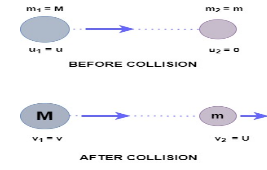Question
Question: A big ball of mass M, moving with velocity u strikes a small ball of mass m, which is at rest. Final...
A big ball of mass M, moving with velocity u strikes a small ball of mass m, which is at rest. Finally small ball attains velocity u and big ball v. What is the value of v:-
(A) (MM−m)u
(B) (M+mm)u
(C) M+m2m
(D) (M+mM)v
Solution
Here, we apply the law of conservation of linear momentum, according to this principle, if two objects collide, then the total momentum before and after will be the same if there is no external force acting on the colliding objects.
i.e., Initial Momentum = Final Momentum
Pi=Pf
Use linear momentum formula,
Here, m is the mass of body, v is velocity of body,
Complete step by step solution
We have given,
A big ball having mass = M
Velocity of big ball before collision = u
Mass of small ball = m
Initially small ball is at rest
Hence, velocity of small ball before collision = 0

After collision,
Velocity of small ball = u
Velocity of big ball = v
Apply law of conservation of linear momentum
Pi=Pf
Here, Pi is initial linear momentum before collision and Pf is final linear momentum after collision
m1u1+m2u2=m1v1+m2v2 --------(1)
Put, m1=M [mass of big ball ]
m2=m [mass of small ball]
u1=u [velocity of big ball] before collision
u2=0 [velocity of small ball] before collision
After collision, v1=v [velocity of big ball]
v2=u [velocity of small ball]
Put all the values in eq. (1).
Mu + m(0) = Mv + mu
Mu = Mv + mu
Mv = Mu − mu
V=(MM−m)u
Hence, option A is correct.
Note
The law of conservation of momentum can be explained from Newton's 2nd law of motion. Newton’s 2nd law of motion says that the rate of change of linear momentum of a body is equal to the net force applied to it, i.e., dtdp=Fnet . If net force acting on body is zero, the rate of change of momentum is also zero,
dtdp=0 [∵Fnet=0]
P = constant
It means that there is no change in momentum.
